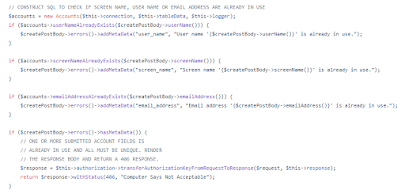After reorganizing Mabel to reflect the decision to move my dependency declarations out of docroot/index.php and to switch to a 'one endpoint one class' approach, it was time to dig back in and go to an even greater level of detail.
Authorization seemed like a good place to start but I also wanted to flesh out the data model for user information, so I began with POST /account/create.
The business logic for this controller should be something like:
- Confirm that the request has the authorization header and throw an exception, log it and return a 400 Computer Says No response if it doesn't.
- Get the value of the authorization header.
- If the value is an empty string, generate a new value and save it to persistent storage in an unauthorized state.
- If the value is not an empty string, attempt to load it from persistent storage.
- If the value cannot be loaded from persistent storage, generate a new value and save it to persistent storage in an unauthorized state.
- If the value exists in persistent storage in an authorized state return a 403 Computer Says Forbidden response. You should not be attempting to create a new user account if you're already authorized.
- If the value exists in persistent storage in an unauthorized state we're golden. Continue on.
- Get the post data from the body of the request and translate it into something the code can work with.
- Validate the translated data for the existence of all required fields, that those fields don't contain invalid data and that they're neither too long or too short.
- If the translated data failed validation, return a 406 Computer Says Not Acceptable response.
- Confirm that no other already persisted user has the same User Name, Screen Name or Email Address included in the translated data.
- If one or more of these three fields are already in use, return a 406 Computer Says Not Acceptable response.
- Save the translated data to persistent storage, thus creating the new user account.
- Update the authorization header value saved in persistent storage to an authorized state.
- Return a 200 OK response.
So yeah, that's basically what's happening behind the scenes for that particular endpoint. The other endpoints are largely variations on the same theme.

No comments:
Post a Comment